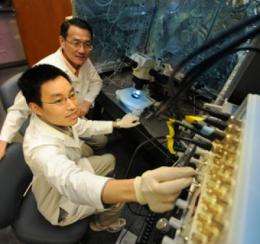Strong communication between brain and muscle requires both having the protein LRP4

Communication between the brain and muscle must be strong for us to eat, breathe or walk. Now scientists have found that a protein known to be on the surface of muscle cells must be present in both tissues to ensure the conversation is robust.
Scientists at the Medical College of Georgia at Georgia Health Sciences University have shown that without LRP4 in muscle cells and neurons, communication between the two cells types is inefficient and short-lived.
Problems with the protein appear to contribute to disabling disorders such as myasthenia gravis and other forms of muscular dystrophy. The MCG scientists reported finding antibodies to LRP4 in the blood of about 2 percent of patients with muscle-degenerating myasthenia gravis in Archives of Neurology earlier this year.
Scientists know that LRP4 plays an important role in the muscle cell, where it receives cues from the brain cell that it's time to form the receptors that will be enable ongoing communication between the two, said Dr. Lin Mei, Director of the GHSU Institute of Molecular Medicine and Genetics and corresponding author of the study in the journal Neuron.
However when Dr. Haitao Wu deleted LRP4 just from muscle cells, a connection – albeit a weak one – still formed between muscle and brain cells. The mice survived several days during which they experienced some of the same muscle weakness as patients with myasthenia gravis. "That's against the dogma," Mei said. "If LRP4 is essential only in the muscle cells, how could the mice survive?" When they totally eliminated LRP4, neuromuscular junctions never formed and the mice didn't survive.
Additional evidence suggests that LRP4 in the neurons is vital, said Wu, postdoctoral fellow and the study's first author. "When we knocked out the LRP4 gene in the muscles, there was some redundant function coming from the motor neuron, like a rescue attempt," he said. They documented the neuron reaching out to share LRP4 with the muscle cell. Unfortunately, the gesture was not sufficient.
"The nerve does not get the stop signal," Mei said, referencing images of too-long neurons that never got the message from the muscle that they have gone far enough. When they cut the elongated nerves, they found they didn't contain enough vesicles, little packages of chemical messengers that are the hallmark of brain cell communication. On the receiving end, muscle cells developed receptors that were too small and too few – hence, the tenuous communication network. "When LRP4 in the muscle is taken out, not surprisingly, the muscle has some kind of a problem," Mei said. "What was very surprising was that the motor neurons also have problems."
"The talk between motor neurons and muscle cells is very critical to the synapse formation and the very precise action between the two," Wu said. Mei's lab earlier established that the conversation goes both ways.
The scientists believe about 60 percent of the LRP4 comes from muscle cells, about 20 percent from brain cells – which helps explain why the brain's effort to share is insufficient – and the remainder from cells in spaces between the two. In addition to better explaining nerve-muscle communication, the scientists hope their findings will eventually enable gene therapy that delivers LRP4 to bolster insufficient levels in patients.
Other early and key players in establishing nerve-muscle conversation include agrin, a protein that motor neurons release to direct construction of the synapse, a sort of telephone line between the nerve and muscle. MuSK on the muscle cell surface initiates critical internal cell talk so synapses can form and receptors that enable specific commands will cluster at just the right spot.
Mei's lab reported in Neuron in 2008 that agrin starts talking with LRP4 on the muscle cell surface, then recruits the enzyme MuSK to join the conversation. LRP4 and MuSK become major components of the receptor needed for the muscle cell to receive the message agrin is sending.
The agrin-MuSK signaling pathway has been implicated in muscular dystrophy, a group of genetic diseases that lead to loss of muscle control because of problems with neurons, muscle cells and/or their communication. Some reports have implicated a mutant MuSK as a cause of muscular dystrophy and autoantibodies (antibodies the body makes against itself) to MuSK have been found in the blood of some patients.



















